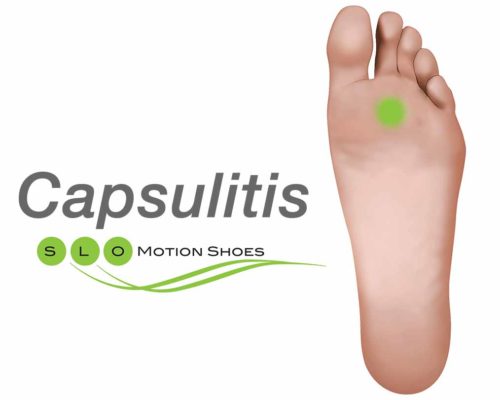Capsulitis, which is inflammation of a joint capsule, is a common source of pain to the ball of your foot (forefoot). The capsule is the fluid filled outer covering that joins two bones to make a joint. The capsule functions to keep the bones close together and aligned so the joint can function in its optimal range. Capsulitis in the foot most commonly involves the capsule that joins the second metatarsal (one of five bones in the midfoot) to the second toe bones.

Symptoms
• Pain in the ball of the foot at the base of affected toe (usually the second)
• Pain increases with walking and is relieved with rest
• Sharp pain with occasional radiation to the toes
• Pain increases while walking barefoot on hard surface
• Swelling of the affected area in the ball of the foot and on the top of the toe joint
Causes
• Excessive pressure on the forefoot and joint
• Stress on the joint from trauma or abnormal biomechanical functioning
• Abnormal foot pronation (rolling inward)
• Wearing shoes with an elevated toe area
Treatment
• Focus is on decreasing inflammation and pressure on affected joint. There are surgical options if conservative therapy does not relieve pain.
• Wear a supportive shoe of adequate width with cushioning in the forefoot area.
• Over the counter or customized padded orthotic to relieve pressure.
• Ice to affected area.
• Take an over-the-counter pain medication, such as ibuprofen (Advil, Motrin) or naproxen (Aleve) as needed for pain.
• Cortisone injection into the joint.
• Avoid walking barefoot during treatment period.
Capuslitis refers to inflammation of the tissues surrounding a joint. Capsulitis in the foot most commonly involves the joint tissue surround the second toe and the metatarsalphalangeal joint. The common location of this condition is generally related to increased pressures in the second metatarsal during heel lift while walking. Abnormal foot pronation (rolling in) and the relative increase length of this metatarsal compare to the other metatarsals puts at risk for injury.
Initial weight bearing to the bottom of the second metatarsal bone in conjunction with diffuse swelling on the top of the toe joint are usually noted. If untreated, the joint capsule or plantar plate on the bottom of the second metatarsal can develop at tear which creates instability of the joint leading to a hammertoe deformity. X-rays and MRI’s may be needed to assist in the diagnosis.
Treatment is aimed at decreasing the pressure on the second metatarsal during walking with the use of a supportive shoe and orthotic as well as the short term use of anti-inflammatory medications. An orthotic that is placed in the shoe typically will have padding to help relieve additional pressure on the second metatarsal bone. Anti-inflammatory medications including ice, NSAIDS like ibuprofen or naproxen as well as cortisone can be used. Cortisone must be used cautiously and in some instances can lead to the development of a hammertoe.
Capsulitis Discussion Board
Select a View
Click on the view that most represents the area of discomfort that you are experiencing. Drag your cursor over your area of concern to obtain a brief description of the potential condition.
Suggested Products
-

Capsulitis Orthotic
$75.00Helps reduce the pressures that lead to the inflammation on the second metatarsal joint.Select options







